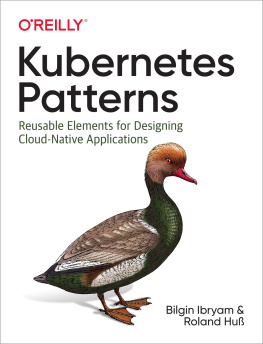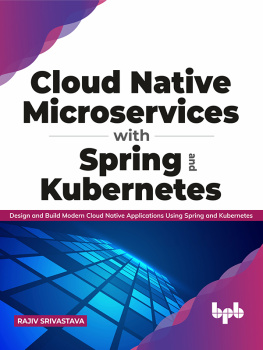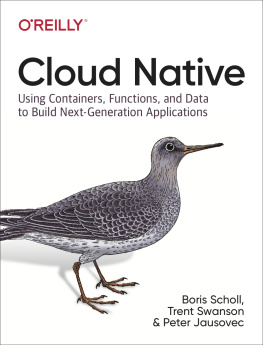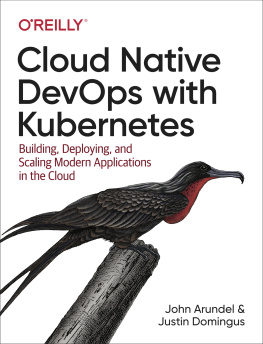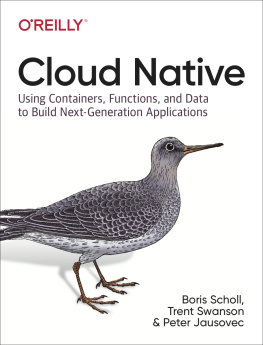Kubernetes Patterns
by Bilgin Ibryam and Roland Hu
Copyright 2019 Bilgin Ibryam and Roland Hu. All rights reserved.
Printed in the United States of America.
Published by OReilly Media, Inc. , 1005 Gravenstein Highway North, Sebastopol, CA 95472.
OReilly books may be purchased for educational, business, or sales promotional use. Online editions are also available for most titles (http://oreilly.com). For more information, contact our corporate/institutional sales department: 800-998-9938 or corporate@oreilly.com .
- Acquisitions Editor: John Devins
- Development Editor: Virginia Wilson
- Production Editor: Katherine Tozer
- Copyeditor: Christine Edwards
- Proofreader: Sharon Wilkey
- Indexer: Judith McConville
- Interior Designer: David Futato
- Cover Designer: Karen Montgomery
- Illustrator: Rebecca Demarest
Revision History for the First Edition
- 2019-04-04: First Release
See https://www.oreilly.com/catalog/errata.csp?isbn=9781492050285 for release details.
The OReilly logo is a registered trademark of OReilly Media, Inc. Kubernetes Patterns, the cover image, and related trade dress are trademarks of OReilly Media, Inc.
The views expressed in this work are those of the authors, and do not represent the publishers views. While the publisher and the authors have used good faith efforts to ensure that the information and instructions contained in this work are accurate, the publisher and the authors disclaim all responsibility for errors or omissions, including without limitation responsibility for damages resulting from the use of or reliance on this work. Use of the information and instructions contained in this work is at your own risk. If any code samples or other technology this work contains or describes is subject to open source licenses or the intellectual property rights of others, it is your responsibility to ensure that your use thereof complies with such licenses and/or rights.
978-1-492-05028-5
[LSI]
Foreword
When Craig, Joe, and I started Kubernetes nearly five years ago, I think we all recognized its power to transform the way the world developed and delivered software. I dont think we knew, or even hoped to believe, how quickly this transformation would come. Kubernetes is now the foundation for the development of portable, reliable systems spanning the major public clouds, private clouds, and bare-metal environments. However, even as Kubernetes has become ubiquitous to the point where you can spin up a cluster in the cloud in less than five minutes, it is still far less obvious to determine where to go once you have created that cluster. It is fantastic that we have seen such significant strides forward in the operationalization of Kubernetes itself, but it is only a part of the solution. It is the foundation on which applications will be built, and it provides a large library of APIs and tools for building these applications, but it does little to provide the application architect or developer with any hints or guidance for how these various pieces can be combined into a complete, reliable system that satisfies their business needs and goals.
Although the necessary perspective and experience for what to do with your Kubernetes cluster can be achieved through past experience with similar systems, or via trial and error, this is expensive both in terms of time and the quality of systems delivered to our end users. When you are starting to deliver mission-critical services on top of a system like Kubernetes, learning your way via trial and error simply takes too much time and results in very real problems of downtime and disruption.
This then is why Bilgin and Rolands book is so valuable. Kubernetes Patterns enables you to learn from the previous experience that we have encoded into the APIs and tools that make up Kubernetes. Kubernetes is the by-product of the communitys experience building and delivering many different, reliable distributed systems in a variety of different environments. Each object and capability added to Kubernetes represents a foundational tool that has been designed and purpose-built to solve a specific need for the software designer. This book explains how the concepts in Kubernetes solve real-world problems and how to adapt and use these concepts to build the system that you are working on today.
In developing Kubernetes, we always said that our North Star was making the development of distributed systems a CS 101 exercise. If we have managed to achieve that goal successfully, it is books like this one that are the textbooks for such a class. Bilgin and Roland have captured the essential tools of the Kubernetes developer and distilled them into segments that are easy to approach and consume. As you finish this book, you will become aware not just of the components available to you in Kubernetes, but also the why and how of building systems with those components.
Brendan Burns,
Cofounder, Kubernetes
Preface
With the evolution of microservices and containers in recent years, the way we design, develop, and run software has changed significantly. Todays applications are optimized for scalability, elasticity, failure, and speed of change. Driven by new principles, these modern architectures require a different set of patterns and practices. This book aims to help developers create cloud-native applications with Kubernetes as a runtime platform. First, lets take a brief look at the two primary ingredients of this book: Kubernetes and design patterns.
Kubernetes
Kubernetes is a container orchestration platform. The origin of Kubernetes lies somewhere in the Google data centers where Googles internal container orchestration platform, Borg, was born. Google used Borg for many years to run its applications. In 2014, Google decided to transfer its experience with Borg into a new open source project called Kubernetes (Greek for helmsman or pilot), and in 2015, it became the first project donated to the newly founded Cloud Native Computing Foundation (CNCF).
Right from the start, Kubernetes gained a whole community of users, and the number of contributors grew at an incredibly fast pace. Today, Kubernetes is considered one of the most active projects on GitHub. It is probably fair to claim that at the time of this writing, Kubernetes is the most commonly used and feature-rich container orchestration platform. Kubernetes also forms the foundation of other platforms built on top of it. The most prominent of those Platform-as-a-Service systems is Red Hat OpenShift, which provides various additional capabilities to Kubernetes, including ways to build applications within the platform. These are only some of the reasons we chose Kubernetes as the reference platform for the cloud-native patterns in this book.
This book assumes you have some basic knowledge of Kubernetes.In , we recapitulate the core Kubernetes concepts and lay out the foundation for the following patterns.
Design Patterns
The concept of design patterns dates back to the 1970s and from the field of architecture. Christopher Alexander, an architect and system theorist, and his team published the groundbreaking A Pattern Language (Oxford University Press) in 1977, which describes architectural patterns for creating towns, buildings, and other construction projects. Sometime later this idea was adopted by the newly formed software industry. The most famous book in this area is

